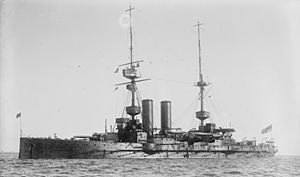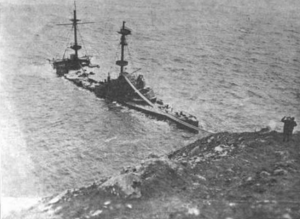HMS Montagu (1901) facts for kids

Montagu's sister ship HMS Albemarle
|
|
Quick facts for kids History |
|
|---|---|
| Name | HMS Montagu |
| Namesake | Ralph Montagu, 3rd Baron Montagu of Boughton, 1st Earl of Montagu |
| Builder | Devonport Dockyard |
| Laid down | 23 November 1899 |
| Launched | 5 March 1901 |
| Commissioned | 28 July 1903 |
| Fate | Wrecked on Lundy Island, 30 May 1906 |
| General characteristics | |
| Class and type | Duncan-class pre-dreadnought battleship |
| Displacement | |
| Length | 432 ft (132 m) (loa) |
| Beam | 75 ft 6 in (23.01 m) |
| Draught | 25 ft 9 in (7.85 m) |
| Installed power |
|
| Propulsion |
|
| Speed | 19 knots (35 km/h; 22 mph) |
| Range | 6,070 nmi (11,240 km; 6,990 mi) at 10 knots (19 km/h; 12 mph) |
| Complement | 720 |
| Armament |
|
| Armour |
|
The HMS Montagu was a powerful warship called a battleship in the British Royal Navy. It was part of the Duncan class of ships, built to be faster than new Russian warships. The Montagu and its sister ships could travel at 19 knots, making them some of the fastest battleships in the world at the time.
These ships were armed with four large 12-inch guns and were similar to the London-class battleships. However, the Duncan class was a bit lighter and had thinner armour. The Montagu was built between November 1899 and July 1903. Its career was short. It served for two years in the Mediterranean Fleet before moving to the Channel Fleet in 1905. In May 1906, while testing new wireless telegraphy equipment, the ship ran aground off Lundy Island. Many attempts were made to free the ship, but they all failed. The Montagu was eventually broken up right where it was stuck.
Contents
Building the Duncan-Class Battleships
The Royal Navy ordered six Duncan-class battleships, including the Montagu, to respond to fast Russian battleships launched in 1898. William Henry White, who designed ships for the British Navy, made the Duncan class to match the speed of these Russian ships.
To make the ships faster without making them too big, White had to reduce their armour protection. This meant the Duncan ships were like bigger, improved versions of the earlier Canopus-class ships. They were not as strong defensively as some other British battleships like the Majestic or London classes. Even though they had less armour, the Duncan ships were still much better than the Russian ships they were built to fight.
Size and Speed of HMS Montagu
The Montagu was about 432 feet long. It was 75 feet and 6 inches wide, and its bottom sat 25 feet and 9 inches deep in the water. The ship weighed between 13,270 and 13,745 long tons normally. When fully loaded, it could weigh up to 15,200 long tons. A crew of 720 officers and sailors worked on the ship.
The Duncan-class ships used two large engines that turned two propellers. Twenty-four Belleville boilers created the steam needed for the engines. These boilers sent smoke through two tall funnels in the middle of the ship. The Montagu and its sister ships could reach a top speed of 19 knots, making them the fastest battleships in the world for several years. At a slower speed of 10 knots, the ship could travel about 6,070 nautical miles before needing to refuel.
Weapons and Armour of HMS Montagu
The Montagu's main weapons were four 12-inch guns. These were placed in two gun turrets, one at the front and one at the back of the ship. For its secondary weapons, the ship had twelve 6-inch guns. These were placed in armoured sections called casemates along the sides.
The ship also carried ten 12-pounder (3-inch) guns and six 3-pounder (47 mm) guns. These smaller guns were for defending against fast torpedo boats. Like other battleships of its time, the Montagu also had four 18-inch torpedo tubes built into its hull below the waterline.
The Montagu had an armoured belt that was 7 inches thick around its middle. The armoured walls at the ends of this belt were between 7 and 11 inches thick. The sides of the main gun turrets were 8 to 10 inches thick, sitting on top of 11-inch thick armoured bases called barbettes. The casemate guns were protected by 6 inches of Krupp steel. The ship's conning tower, where the ship was controlled, had 12-inch thick sides. The Montagu also had two armoured decks, which were 1 and 2 inches thick.
Service History
The construction of HMS Montagu began on 23 November 1899. Its hull was launched into the water on 5 March 1901. The ship started its sea trials (tests) in February 1903. It was officially put into service on 28 July at Devonport Dockyard. The Montagu then joined the Mediterranean Fleet. In February 1905, it was moved to the Channel Fleet.
Running Aground and Loss
In late May 1906, the Montagu was testing new wireless telegraphy equipment in the Bristol Channel. It was sending and receiving test messages with shore stations. On the night of 29 May, the ship was anchored near Lundy Island. However, it could not pick up the test messages. So, the ship lifted its anchor and started sailing towards the Isles of Scilly.
Heavy fog forced the ship to turn back towards Lundy Island after four hours. But the ship's navigator made a mistake, putting the ship about two miles off its planned path. The Montagu met a pilot cutter (a small boat that helps guide ships) near Lundy Island. The battleship stopped and asked the cutter for its distance and direction to Hartland Point on the mainland. The cutter gave the correct information. However, someone from the battleship's bridge replied that the information must be wrong and that the pilot cutter must be lost. As the Montagu started its engines and moved forward, the cutter shouted back that the battleship would hit Shutter Rock in ten minutes. A short time later, the sound of the battleship running aground was heard through the fog.
At 2:00 AM on 30 May, the Montagu hit Shutter Rock. It suffered a 91-foot long gash on its right (starboard) side. The ship could not free itself and slowly began to fill with water. Twenty-four hours later, its starboard engine room and all its boiler rooms were flooded. The crew then intentionally flooded the left (port) engine room to stop the ship from leaning too much to the right.
Divers checked the hull to see how bad the damage was. It turned out to be much worse than first thought. The bottom of the ship had many other holes. The left propeller shaft had been ripped off the hull. The right bilge keel (a fin that helps stabilize the ship) was also torn off, as was the rudder. The wreck was resting on a fairly flat seabed, so there was still hope that the ship could be freed.
Salvage Attempts and Abandonment
The Royal Navy did not have a special team for salvaging (saving) ships. So, they hired Frederick Young, a former Royal Navy captain. He was the best expert on marine salvage in Britain at the time. Young advised Admiral Sir Arthur Wilson, the commander of the Channel Fleet, who had no experience in salvage.
The navy first hoped to make the ship lighter by removing its medium and small guns and other equipment. Then, they planned to pump out the water so the holes could be patched. By the end of June, about twenty pumps were at the site. They could pump out 8,600 tons of water per hour. However, pumping was difficult because of the ship's internal sections. Also, they had to let water back into the ship during high tide to prevent more damage before the hull could be patched. Because of these problems, the salvage team gave up on this plan.
Admiral Wilson then tried to remove armour plates from the ship's sides. He also tried to build special sealed chambers called caissons. A powerful air pump would then blow the water out of the hull. But the caissons kept breaking free even in calm seas, and the air pump did not work as planned. The Montagu's sister ship, Duncan, even ran aground while trying to help with the salvage, though it was successfully freed.
At the end of summer 1906, salvage efforts were stopped for the year. There were plans to try again in 1907. However, an inspection in October 1906 found that the sea was pushing the ship further ashore. Its hull was bending and twisting, its seams were opening, its deck planks were coming apart, and its boat davits (cranes for boats) had collapsed. Since they could not refloat the Montagu, the navy decided to give up. More equipment was removed from the wreck, including its main guns, which were later used on other ships.
The Western Marine Salvage Company of Penzance finished salvaging the wreck for scrap metal over the next 15 years. A court martial (a military trial) was held to investigate the wreck. It blamed the thick fog and faulty navigation. The trial took place aboard HMS Victory. The ship's captain, Thomas Adair, and the navigation officer, Lieutenant James Dathan, were strongly criticized. Both men were removed from HMS Montagu. Dathan also lost two years of seniority in his rank.
Today, the wreck site is mostly just some armour plate on the seabed. It is a popular spot for divers. Divers have also found parts of its gun turrets and shells that were not recovered during the salvage. In September 2019, the British Government gave the wreck site, including steps carved into the cliff during the salvage, protected status.


